new generation of "tabletop" particle accelerators that are less expensive for use in science and medicine.

Current state-of-the-art accelerators use microwaves to boost the energy of electrons. Researchers have sought more economical alternatives, and this new technique, which uses ultrafast lasers to drive the accelerator, is a leading candidate.
A team that included scientists from the SLAC National Accelerator
Laboratory and Stanford University used a device powered by a
titanium:sapphire laser — a cheaper power source than those used in
radio-frequency accelerators — to accelerate electrons at a rate 10
times higher than conventional technology in a
nanostructured glass chip
smaller than a grain of rice.
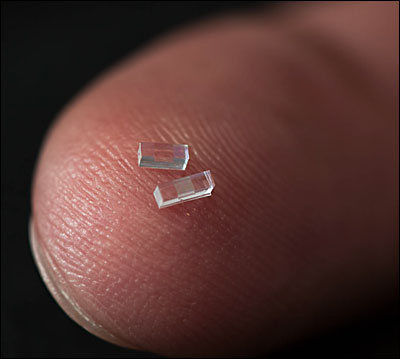
Nanofabricated chips of fused silica just 3 mm long were used to accelerate electrons at a rate 10 times higher than conventional particle accelerator technology. Courtesy of Brad Plummer/SLAC.
"We still have a number of challenges before this technology becomes practical for real-world use, but, eventually, it would substantially reduce the size and cost of future high-energy particle colliders for exploring the world of fundamental particles and forces," said Joel England, the SLAC physicist who led the experiments. "It could also help enable compact accelerators and x-ray devices for security scanning, medical therapy and imaging, and research in biology and materials science."
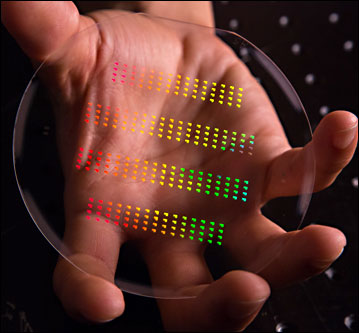
The nanoscale patterns of SLAC and Stanford's accelerator on a chip gleam in rainbow colors before being assembled and cut into their final forms. Courtesy of Matt Beardsley/SLAC.
At its full potential, the new "accelerator on a chip" could match the accelerating power of SLAC's 2-mile-long linear accelerator in just 100 feet, and deliver a million more electron pulses per second. The initial demonstration achieved an acceleration gradient (amount of energy gained per length) of 300 million eV per meter. That's roughly 10 times the acceleration provided by the current SLAC linear accelerator, the researchers say.
"Our ultimate goal for this structure is 1 billion electronvolts per meter, and we're already one-third of the way in our first experiment," said Stanford professor and principal investigator Robert Byer.
Particles are generally accelerated in two stages. First they are boosted to nearly the speed of light. Then, any additional acceleration increases their energy, but not their speed; this is the challenging part.
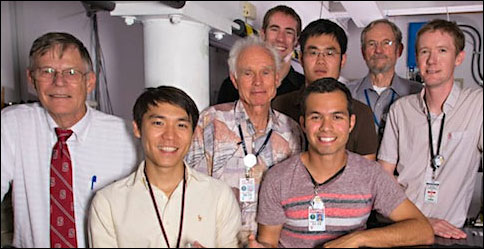
Many of the SLAC and Stanford researchers who helped create the accelerator on a chip are pictured in SLAC's NLCTA lab, where the experiments took place. Left to right: Robert Byer, Ken Soong, Dieter Walz, Ken Leedle, Ziran Wu, Edgar Peralta, Jim Spencer and Joel England. Courtesy of Matt Beardsley/SLAC.
In the accelerator-on-a-chip experiments, electrons were accelerated to near-light-speed in a conventional accelerator, then focused into a half-micron-high channel within a fused silica glass chip 0.5 mm long. The channel was patterned with precisely spaced nanoscale ridges; infrared laser light shining on the pattern generated electrical fields that interacted with the electrons in the channel to boost their energy.
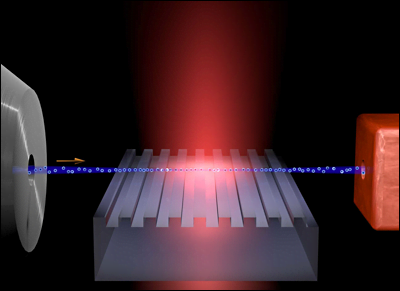
Shining a laser pulse onto a grating accelerates electrons passing just over it, which could enable lab-sized accelerators and tunable x-ray sources. Courtesy of J. Breuer/MPI.
The work was reported Sept. 27 in
Nature.
Turning the accelerator on a chip into a full-fledged tabletop
accelerator will require a more compact way to get the electrons up to
speed before they enter the device.
A collaborating research group in Germany, led by Peter Hommelhoff at Max Planck Institute of Quantum
Optics, has been looking for such a solution. It simultaneously reports in
Physical Review Letters its success in using a laser to accelerate lower-energy electrons (Laser-Based Acceleration of Nonrelativistic Electrons at a Dielectric Structure).
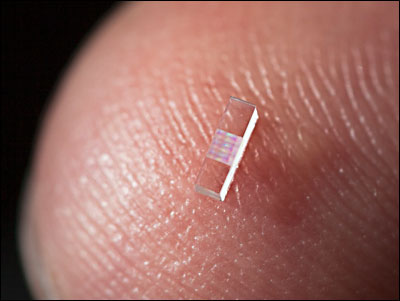
The key to the accelerator chips is tiny, precisely spaced ridges that cause the iridescence seen in this close-up. Courtesy of Brad Plummer/SLAC.
Byer said laser accelerators could drive compact x-ray free-electron
lasers — comparable to SLAC's Linac Coherent Light Source — that are
all-purpose tools for a wide range of research.
Another possible application is small, portable x-ray sources to improve medical care for people injured in combat as well as to provide more affordable medical imaging for hospitals and laboratories. That's one of the goals of DARPA's Advanced X-Ray Integrated Sources (AXiS) program, which partially funded the research.
For more information, visit:
www.slac.stanford.edu